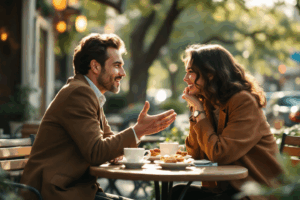
Mental and Emotional Health
"Let's Learn, Explore, and Connect to the World"

The Impact of Technology on Mental Health: Balancing Digital and Real Life
- Patricia Santos
- Mental and Emotional Health

Introduction
 The rise of digital technology over the past few decades has revolutionized the way we live, work, and interact with one another. Technology is now a fundamental part of our everyday lives, used for everything from communication and entertainment to advanced applications like virtual reality and artificial intelligence. This rapid advancement has brought about numerous conveniences and opportunities, enabling us to stay connected, informed, and productive like never before. However, along with these benefits, technology’s pervasive presence has also introduced challenges, particularly concerning our mental health.
The rise of digital technology over the past few decades has revolutionized the way we live, work, and interact with one another. Technology is now a fundamental part of our everyday lives, used for everything from communication and entertainment to advanced applications like virtual reality and artificial intelligence. This rapid advancement has brought about numerous conveniences and opportunities, enabling us to stay connected, informed, and productive like never before. However, along with these benefits, technology’s pervasive presence has also introduced challenges, particularly concerning our mental health.
In today’s digital world, managing our time effectively online and offline is increasingly important. Digital and real-life balance refers to the ability to manage and harmonize our time and activities between the virtual realm and the physical world. It’s crucial to find a balance that allows us to enjoy the benefits of technology without sacrificing our well-being. With the growing concerns about the impact of technology on mental health, it is imperative to explore how our digital habits influence our psychological state and what measures we can take to maintain a healthy equilibrium.
 Understanding how technology affects our mental health is increasingly important. We must identify and address potential negative consequences as we rely more on digital devices. By studying both the benefits and drawbacks of technology and how it influences our minds, we can develop strategies to use technology more healthily. This blog aims to shed light on these aspects and provide practical insights into balancing digital and real life for better mental health.
Understanding how technology affects our mental health is increasingly important. We must identify and address potential negative consequences as we rely more on digital devices. By studying both the benefits and drawbacks of technology and how it influences our minds, we can develop strategies to use technology more healthily. This blog aims to shed light on these aspects and provide practical insights into balancing digital and real life for better mental health.
Benefits of Technology for Mental Health
Technology has dramatically improved mental health care by making it easier to access, increasing public understanding of mental health issues, and fostering stronger social connections. Here are some key positive impacts:
Accessibility to Mental Health Resources and Support

Technology has expanded access to mental health care. Online therapy platforms and mental health apps have made professional help and self-care tools more convenient and affordable, allowing many people to receive support without the barriers of traditional therapy.
Technology has Boosted Awareness and Education about Mental Health

Online platforms have significantly increased awareness and understanding of mental health issues. Websites, social media, and mental health organizations have reduced stigma by sharing information and encouraging open conversations. This has empowered people to seek help and created a more supportive society.
Social Connectivity and Support through Social Media and Communication Platforms

Social media has transformed how we connect with others, creating new ways to find support and community. Online platforms offer spaces where people facing similar challenges can share experiences, offer advice, and find emotional support. This virtual community can be especially helpful for those struggling with mental health.
In summary, while technology presents certain challenges, it offers numerous benefits that can significantly enhance mental health. By increasing accessibility to resources, raising awareness, and fostering social connections, technology plays a vital role in supporting mental well-being in the digital age.
Harmful Effects of Technology on Mental Health
While technology offers many benefits, its pervasive presence also brings significant challenges that can negatively impact mental health. Here are some of the key negative impacts:
Social Media and Its Effects on Body Image and Self-Confidence

Social media can negatively hurt self-esteem and body image. Constant exposure to carefully crafted and often unrealistic images online can lead people to compare themselves unfavorably to others. This can result in feelings of inadequacy and low self-worth, especially among young people.
The Phenomenon of Cyberbullying and Online Harassment

Cyberbullying and online harassment, made easier by the internet’s anonymity, can severely harm mental health. Unlike traditional bullying, it can happen anytime and anywhere, leaving victims feeling trapped and isolated. Constant online abuse can lead to anxiety, depression, and even suicidal thoughts. Victims often struggle to escape or get help due to the nature of the attacks, causing significant emotional distress and a sense of insecurity.
Overstimulation and the Impact of Constant Connectivity on Anxiety and Stress

Excessive technology use can harm mental well-being. The constant stream of notifications and information creates stress and anxiety. Difficulty disconnecting from devices can disrupt sleep and lead to burnout. Technology can also blur personal boundaries, making it hard to relax. It has both benefits and drawbacks for mental health, and it’s important to be aware of the potential negative effects.
The Science Behind Technology and Mental Health
The intersection of technology use and mental health has become a focal point of research in recent years. Research has shown how using digital devices can impact our mental health. This section delves into the key findings of these studies, exploring the effects of screen time on sleep patterns and cognitive functions, as well as the role of dopamine and instant gratification in technology addiction.
Research Studies on Technology Use and Mental Health Outcomes

Numerous studies have examined the relationship between technology use and mental health, revealing a complex interplay of factors. Research published in journals like Cyberpsychology, Behavior, and Social Networking and Journal of the American Medical Association has found correlations between high levels of social media use and an increased number of people with depression, anxiety, and loneliness. For instance, a study by the University of Pennsylvania demonstrated that limiting social media use to 30 minutes daily significantly reduced feelings of loneliness and depression among participants. These findings suggest that while technology can offer social benefits, excessive use may contribute to adverse mental health outcomes.
How Screen Time Affects Sleep and Thinking

Screen time, especially before bed, can harm sleep and thinking. The blue light from screens interferes with sleep, causing problems falling asleep and poor sleep quality. Lack of sleep is connected with mental health issues like stress, anxiety, and depression. Not sleeping enough can also make it harder to think clearly and remember things.
The Role of Dopamine and Instant Gratification in Technology Addiction

Engaging in social media, gaming, and online shopping can trigger the brain’s reward system, releasing dopamine, a chemical linked to pleasure. This can lead to a cycle of pursuing constant, short-lived rewards from digital experiences. Over time, this can contribute to technology addiction, characterized by compulsive use of digital devices despite negative consequences. Research in Frontiers in Psychology has shown that technology addiction shares similarities with other behavioral addictions, such as gambling, in terms of its impact on the brain’s reward pathways and overall mental health.
In summary, scientific research underscores the need for mindful and balanced technology use. By understanding how technology affects our mental health, we can develop strategies to mitigate its negative impacts and promote healthier digital habits. This knowledge is crucial for individuals, parents, educators, and policymakers striving to foster a more balanced relationship with technology.
Balancing Digital and Real Life
Achieving a healthy balance between digital and real life is crucial for maintaining mental well-being in today’s tech-driven world. Here are some effective strategies to help set boundaries with technology use, the importance of digital detoxes, and ways to encourage real-life social interactions and outdoor activities.
Strategies for Setting Boundaries with Technology Use

1. Establish Tech-Free Zones and Times: Designate particular rooms in your house, like the bedroom or dining room, as technology-free zones. Additionally, set designated times during the day when you refrain from using technology, such as during meals or an hour before bedtime.

2. Use Digital Well-being Tools: Many devices and apps offer monitoring and limiting screen time features. Utilize these tools to set daily usage limits for social media, games, and other distracting applications. This can help you stay aware of your digital habits and make conscious decisions about your technology use.

3. Prioritize Tasks and Set Goals: Organize your day by prioritizing tasks that require focus and creativity without digital distractions. Set clear goals for your screen time, ensuring that it aligns with your personal and professional objectives rather than mindless scrolling.

4. Practice Mindful Usage: Be intentional about your technology use by asking yourself why you are reaching for your device. Are you using it for a specific purpose or succumbing to boredom or habit? Mindful usage can reduce unnecessary screen time and promote healthier digital habits.
The Importance of Digital Detoxes and Unplugging Regularly

1. Scheduled Digital Detoxes: Plan regular breaks from digital devices, such as a weekend digital detox or a screen-free day each week. Use this time to do activities that don’t require screens, like reading, working out, or spending time with family and friends.

2. Benefits of Unplugging: Disconnecting from technology helps your mind relax and recover, lessening feelings of stress and worry. It can also improve sleep quality by minimizing exposure to blue light before bedtime. Disconnecting helps you reconnect with yourself and the physical world around you.

3. Encouraging Real-Life Social Interactions and Outdoor Activities:

4. Foster Face-to-Face Connections: Make a conscious effort to engage in real-life social interactions. Bond with friends and family, join community events, or find groups with shared interests. Face-to-face interactions provide emotional support and strengthen relationships, which are essential for mental health.

5. Embrace Outdoor Activities: Spending time outdoors can significantly improve mental health by reducing stress, lifting your mood, and boosting overall well-being. Enjoy activities like hiking, biking, or simply walking in nature. These activities provide a break from screens and offer physical exercise and relaxation opportunities.

6. Combine Social and Outdoor Activities: Organize group activities that involve outdoor experiences, such as picnics, sports, or nature walks. This promotes physical health, enhances social bonds, and provides a refreshing break from digital environments.
In conclusion, balancing digital and real-life requires conscious effort and intentionality. By setting limits on technology use, taking breaks from screens, and spending more time with people and outdoors, you can improve your relationship with technology and enhance your mental well-being. These strategies empower you to enjoy the benefits of technology without compromising your overall quality of life.
The Role of Parents and Educators
 Parents and educators are pivotal in guiding children and adolescents toward healthy technology use. They can help young people navigate the digital world safely and effectively by fostering an environment that promotes balance and awareness.
Parents and educators are pivotal in guiding children and adolescents toward healthy technology use. They can help young people navigate the digital world safely and effectively by fostering an environment that promotes balance and awareness.
Guiding Children and Adolescents in Healthy Technology Use
1. Modeling Balanced Behavior: Parents and educators should lead by example, demonstrating balanced technology use. Setting limits on screen time and prioritizing offline activities can show children the importance of a healthy digital balance.
2. Setting Clear Boundaries: Establish rules for technology use, such as designated screen-free times or areas in the home and school. Promote physical activity, hobbies, and in-person social interaction for children.
3. Educating About Online Safety: Educate children about internet dangers, such as cyberbullying, privacy risks, and the importance of thinking critically about online information. Emphasize the need for respectful online behavior and the impact of their digital footprint.
Implementing Educational Programs on Digital Literacy and Mental Health

1. Incorporating Digital Literacy into the Curriculum: Schools should teach students how to use technology responsibly, stay safe online, and understand the impact of their online actions. These programs should also cover the benefits and risks associated with digital tools.
2. Mental Health Education: Mental health awareness should be a key component of the educational curriculum. Equipping students with mental health knowledge can help them identify signs of stress, anxiety, or depression and encourage them to seek support when needed.
3. Workshops and Seminars: Host workshops and seminars for parents, teachers, and students to discuss technology’s impact on mental health. These events can offer practical tips and strategies for managing technology use and promoting mental well-being.
Fostering Open Talks About Technology and Mental Health
1. Foster Open Communication: Build a safe space for young people to discuss technology use and mental health concerns. Open dialogue helps understand their experiences and challenges, making it easier to provide guidance and support.
2. Providing Resources and Support: Ensure that children and adolescents have access to mental health resources, including counseling services and helplines. Schools can also provide materials on managing screen time and dealing with online pressures.
3. Building a Community of Support: Create a support network involving parents, teachers, and mental health professionals. This community can collaborate to monitor the impact of technology on students’ mental health and implement effective interventions when necessary.
 In conclusion, educators and parents play a crucial role in shaping the digital habits of the younger generation. By modeling balanced behavior, providing education, and creating a supportive environment, they can help children and adolescents navigate the complexities of the digital world while maintaining their mental health and well-being.
In conclusion, educators and parents play a crucial role in shaping the digital habits of the younger generation. By modeling balanced behavior, providing education, and creating a supportive environment, they can help children and adolescents navigate the complexities of the digital world while maintaining their mental health and well-being.
Technology and Mental Health in the Workplace
The shift to digital communication and remote work has dramatically changed our work. While offering greater flexibility, these changes have also created new challenges that can affect employee well-being.
The Impact of Remote Work and Digital Communication Tools on Employee Well-Being

Remote work and digital communication tools, such as video conferencing and instant messaging, have become integral to many organizations. While they facilitate seamless communication and collaboration, they can blur the lines between work and personal life. This constant connectivity can increase stress and burnout, as employees may feel compelled to be available around the clock. Blending work and home life can lead to feelings of isolation and reduced job satisfaction, negatively impacting overall mental health.
Strategies for Promoting Mental Health in a Digital Workplace

Companies can improve mental health in remote work environments by setting clear work hours, encouraging breaks, and providing mental health resources. Building a supportive and nurturing workplace culture where employees feel comfortable discussing mental health is also essential.
Balancing Productivity and Mental Health in a Tech-Driven Work Environment

Balancing productivity and mental health in a tech-driven work environment requires planning and support. Managers should prioritize realistic workloads and deadlines to prevent overwhelming employees. Regular check-ins and feedback sessions can help identify any issues early and provide opportunities for support. Incorporating team-building activities and fostering social connections among remote workers can alleviate feelings of isolation.
Furthermore, providing training on digital literacy and effective time management can empower employees to use technology efficiently without compromising their mental health.
In conclusion, while technology has transformed the workplace, addressing its impact on employee well-being is essential. Organizations can ensure employees thrive in a digital work environment while maintaining their mental health by implementing supportive strategies and fostering a healthy work culture.
Future Trends and Considerations

As technology evolves, it is crucial to anticipate and address its potential impacts on mental health. Emerging technologies, such as artificial intelligence (AI), virtual reality (VR), and augmented reality (AR), offer both opportunities and challenges for mental well-being. AI-powered mental health tools, like chatbots and diagnostic algorithms, can provide personalized support and early detection of mental health issues. VR and AR applications can offer immersive therapeutic experiences, such as exposure therapy for phobias or anxiety disorders. However, the increasing integration of these technologies also raises concerns about privacy, data security, and the potential for technology overuse or addiction.
Policymakers and tech companies play a pivotal role in promoting healthy technology use. Governments can implement regulations to protect user privacy and ensure the ethical use of emerging technologies. They can also invest in public health campaigns to raise awareness about technology’s potential risks and benefits. Tech companies, on the other hand, can design products with built-in features that promote digital well-being, such as screen time tracking, usage limits, and reminders to take breaks. These companies can create more sustainable and user-friendly digital environments by prioritizing user health.
Looking ahead, the future of technology and mental health will likely involve a greater emphasis on balance and well-being. As awareness of technology’s impact on mental health grows, there will be a greater focus on creating healthier digital environments. While technology offers new mental health support tools, educating users and promoting mindful use is crucial. Combining technological advancements with user education and responsible practices can maximize technology’s benefits while minimizing its negative effects.
Conclusion
 Technology significantly impacts mental health, both positively and negatively. While offering benefits, it also presents challenges. We must understand these effects to promote well-being in the digital age and work together to create a healthier digital environment. This involves balancing technology use with offline activities and creating a society prioritizing mental health alongside technological advancements.
Technology significantly impacts mental health, both positively and negatively. While offering benefits, it also presents challenges. We must understand these effects to promote well-being in the digital age and work together to create a healthier digital environment. This involves balancing technology use with offline activities and creating a society prioritizing mental health alongside technological advancements.
References
- Gregoire, C. (2021, October 5). How to balance your digital and real-life activities for better mental health. HuffPost. Retrieved from https://www.huffpost.com/entry/balance-digital-real-life-mental-health_l_615c9b6fe4b0386378b62299
- Lewis, T. (2020, July 30). The pros and cons of technology for mental health. Psychology Today. Retrieved from https://www.psychologytoday.com/us/blog/technology-and-mental-health/202007/the-pros-and-cons-technology-mental-health
- Santiago, L. (2019, December 11). The impact of social media on body image and self-esteem. Healthline. Retrieved from https://www.healthline.com/health/social-media-body-image
- Smith, A. (2021, June 20). Understanding digital addiction and its effects on the brain. Science Daily. Retrieved from https://www.sciencedaily.com/releases/2021/06/210620101022.htm
- Tatum, M. (2018, November 27). The role of technology in modern workplace mental health. Forbes. Retrieved from https://www.forbes.com/sites/forbestechcouncil/2018/11/27/the-role-of-technology-in-modern-workplace-mental-health/?sh=67e9d562679b
- Wells, G. (2022, March 14). Digital detox: How to unplug and recharge. Harvard Business Review. Retrieved from https://hbr.org/2022/03/digital-detox-how-to-unplug-and-recharge
Latest Blogs

Instagram Reels & Stories: Harnessing the Power of Short-Form Video Content for Engagement and Reach
Digital Marketing Blogs “Let’s Learn, Explore, and Connect to the World” Instagram Reels & Stories: Harnessing the Power of Short-Form Video Content for Engagement and

Facebook Analytics & Conversion Tracking: Attributing Sales and Leads Back to your Facebook Efforts
Digital Marketing Blogs “Let’s Learn, Explore, and Connect to the World” Facebook Analytics & Conversion Tracking: Attributing Sales and Leads Back to your Facebook Efforts
Reading comprehension quiz
Check out our books and more!

Comic Collections : A Compilation of Daily Professional and Casual Conversations (Book 1)
Laugh and learn with ‘Comic Collections’ by Cassia North – a delightful dive into everyday conversations in professional and casual settings, now in a vibrant, humor-filled ebook. Perfect for all ages!
Check out our Blogs!
Read our everyday blogs and gain new knowledge, skills, and inspiration to support your learning journey here in SEKAEL.


Learn through Common English Errors Blogs by recognizing and correcting everyday grammar and usage mistakes.








 The confusion primarily arises from their functions as subject and object pronouns. Many people mistakenly interchange “me” and “I,” leading to sentences that may sound awkward or incorrect. For instance, it’s common to hear someone say, “Me and John went to the store,” instead of the grammatically correct “John and I went to the store.” While often overlooked in casual conversation, such mistakes can be problematic in formal writing and speech.
The confusion primarily arises from their functions as subject and object pronouns. Many people mistakenly interchange “me” and “I,” leading to sentences that may sound awkward or incorrect. For instance, it’s common to hear someone say, “Me and John went to the store,” instead of the grammatically correct “John and I went to the store.” While often overlooked in casual conversation, such mistakes can be problematic in formal writing and speech.























 Understanding the correct usage of “me” and “I” is essential for clear and effective communication in English. Throughout this blog, we have explored the basic grammar rules governing these pronouns, identified common mistakes and misconceptions, and provided practical examples and exercises to enhance comprehension.
Understanding the correct usage of “me” and “I” is essential for clear and effective communication in English. Throughout this blog, we have explored the basic grammar rules governing these pronouns, identified common mistakes and misconceptions, and provided practical examples and exercises to enhance comprehension. To recap, “I” is used as a subject pronoun, performing the action in a sentence, while “me” is used as an object pronoun, receiving the action. Recognizing their roles in different sentence structures is key to avoiding common errors. We also delved into more complex scenarios, such as compound subjects and objects, and provided advanced exercises to reinforce proper usage.
To recap, “I” is used as a subject pronoun, performing the action in a sentence, while “me” is used as an object pronoun, receiving the action. Recognizing their roles in different sentence structures is key to avoiding common errors. We also delved into more complex scenarios, such as compound subjects and objects, and provided advanced exercises to reinforce proper usage. By practicing the tips and mnemonic devices shared in this blog, such as the “Remove the Other Person Test” and the “We and Us Trick,” you can confidently choose the correct pronoun in any context. Regular practice and attention to detail will make these rules second nature.
By practicing the tips and mnemonic devices shared in this blog, such as the “Remove the Other Person Test” and the “We and Us Trick,” you can confidently choose the correct pronoun in any context. Regular practice and attention to detail will make these rules second nature.








 Millions of people around the world are suffering from an unseen widespread loneliness. In an age where technology promises to keep us more connected than ever, the paradox of increasing loneliness is both striking and concerning. The fast-paced nature of modern life, combined with significant societal changes, has led to a rise in individuals feeling isolated despite being physically and virtually surrounded by people.
Millions of people around the world are suffering from an unseen widespread loneliness. In an age where technology promises to keep us more connected than ever, the paradox of increasing loneliness is both striking and concerning. The fast-paced nature of modern life, combined with significant societal changes, has led to a rise in individuals feeling isolated despite being physically and virtually surrounded by people. This blog dives deep into loneliness: what it is, why it happens, and how to deal with it. We’ll explore the feeling itself, its causes and effects, and equip you with practical tools to manage and even overcome it. From building meaningful connections to enhancing self-care and developing a positive mindset, readers will find actionable insights to help them navigate and alleviate loneliness, paving the way toward better mental well-being.
This blog dives deep into loneliness: what it is, why it happens, and how to deal with it. We’ll explore the feeling itself, its causes and effects, and equip you with practical tools to manage and even overcome it. From building meaningful connections to enhancing self-care and developing a positive mindset, readers will find actionable insights to help them navigate and alleviate loneliness, paving the way toward better mental well-being.









 Acceptance is a powerful tool for managing loneliness. Embracing loneliness without judgment involves acknowledging it as a natural part of the human experience rather than a personal failing. This can be achieved through:
Acceptance is a powerful tool for managing loneliness. Embracing loneliness without judgment involves acknowledging it as a natural part of the human experience rather than a personal failing. This can be achieved through:










 Cultivating a positive mindset is crucial in coping with loneliness and enhancing mental well-being. A positive outlook can significantly influence how you perceive and handle feelings of isolation. Three effective practices for developing a positive mindset include keeping a gratitude journal, using positive affirmations, and setting small, achievable goals.
Cultivating a positive mindset is crucial in coping with loneliness and enhancing mental well-being. A positive outlook can significantly influence how you perceive and handle feelings of isolation. Three effective practices for developing a positive mindset include keeping a gratitude journal, using positive affirmations, and setting small, achievable goals.


 Cultivate a positive outlook for better mental well-being. Techniques like expressing gratitude, using positive affirmations, and setting goals can be incorporated into your daily routine. These practices can contribute to a more positive mindset, which is valuable in combating loneliness and promoting overall mental health. These practices shift your focus toward positivity and empower you to take proactive steps toward a fulfilling and connected life.
Cultivate a positive outlook for better mental well-being. Techniques like expressing gratitude, using positive affirmations, and setting goals can be incorporated into your daily routine. These practices can contribute to a more positive mindset, which is valuable in combating loneliness and promoting overall mental health. These practices shift your focus toward positivity and empower you to take proactive steps toward a fulfilling and connected life. Addressing loneliness is a journey that involves self-awareness, building connections, enhancing self-care, and developing a positive mindset. By understanding the different types and causes of loneliness, recognizing its signs, and embracing it without judgment, we lay the foundation for coping effectively. Self-awareness and acceptance are critical first steps in this journey.
Addressing loneliness is a journey that involves self-awareness, building connections, enhancing self-care, and developing a positive mindset. By understanding the different types and causes of loneliness, recognizing its signs, and embracing it without judgment, we lay the foundation for coping effectively. Self-awareness and acceptance are critical first steps in this journey. In conclusion, tackling loneliness is a multifaceted process that requires intentional effort and commitment. Individuals can significantly improve their mental well-being by taking proactive steps and utilizing the strategies discussed. Conquering loneliness and reaching mental well-being is a marathon, not a sprint! Every small step you take is a victory on the path to a happier, healthier you. Embrace the journey with hope and determination, knowing you hold the power to build meaningful connections and create a life that feels fulfilling.
In conclusion, tackling loneliness is a multifaceted process that requires intentional effort and commitment. Individuals can significantly improve their mental well-being by taking proactive steps and utilizing the strategies discussed. Conquering loneliness and reaching mental well-being is a marathon, not a sprint! Every small step you take is a victory on the path to a happier, healthier you. Embrace the journey with hope and determination, knowing you hold the power to build meaningful connections and create a life that feels fulfilling.



 English is a rich and nuanced language with subtleties that can sometimes confound even the most seasoned speakers. Among the common pitfalls that many encounter is the proper use of “less” and “fewer.” While seemingly interchangeable, these two words adhere to specific grammatical rules that distinguish them. Misusing “less” and “fewer” is a frequent error in everyday conversations, marketing materials, and the media. A clear understanding of these terms is key to effective communication.
English is a rich and nuanced language with subtleties that can sometimes confound even the most seasoned speakers. Among the common pitfalls that many encounter is the proper use of “less” and “fewer.” While seemingly interchangeable, these two words adhere to specific grammatical rules that distinguish them. Misusing “less” and “fewer” is a frequent error in everyday conversations, marketing materials, and the media. A clear understanding of these terms is key to effective communication. “Less” and “fewer” serve distinct functions in the English language. “Less” is used with uncountable nouns, referring to a singular mass or quantity that cannot be individually counted, such as “water,” “money,” or “time.” On the other hand, “fewer” is used with countable nouns, indicating several individual items or units, like “books,” “apples,” or “cars.” Despite their clear distinctions, their misuse is rampant, often due to a lack of awareness about these grammatical rules.
“Less” and “fewer” serve distinct functions in the English language. “Less” is used with uncountable nouns, referring to a singular mass or quantity that cannot be individually counted, such as “water,” “money,” or “time.” On the other hand, “fewer” is used with countable nouns, indicating several individual items or units, like “books,” “apples,” or “cars.” Despite their clear distinctions, their misuse is rampant, often due to a lack of awareness about these grammatical rules. The distinction between “less” and “fewer” has been part of English grammar for centuries, tracing its roots back to Old and Middle English. Historically, “less” and “fewer” were used much as they are today, with “less” being used for uncountable nouns and “fewer” for countable nouns. However, the strict application of these rules has not always been as rigid as in modern grammar.
The distinction between “less” and “fewer” has been part of English grammar for centuries, tracing its roots back to Old and Middle English. Historically, “less” and “fewer” were used much as they are today, with “less” being used for uncountable nouns and “fewer” for countable nouns. However, the strict application of these rules has not always been as rigid as in modern grammar. In Old English, the word “less” (derived from the Old English “lǣssa”) was commonly used in contexts where modern English would require “fewer.” Over time, a clearer distinction began to emerge as the language evolved. By the time of Middle English, around the 14th century, “fewer” (from the Old English “fēawer”) started to be used more consistently for countable nouns. This shift reflected a broader trend towards more precise grammatical structures in English.
In Old English, the word “less” (derived from the Old English “lǣssa”) was commonly used in contexts where modern English would require “fewer.” Over time, a clearer distinction began to emerge as the language evolved. By the time of Middle English, around the 14th century, “fewer” (from the Old English “fēawer”) started to be used more consistently for countable nouns. This shift reflected a broader trend towards more precise grammatical structures in English. The authoritarian rule that mandates using “fewer” with countable nouns and “less” with uncountable nouns was more firmly established in the 18th century. Grammarians of that era, such as Robert Lowth, played a significant role in codifying these rules. They advocated for a more standardized approach to grammar, which included the distinction between “less” and “fewer.” This period marked the beginning of modern English grammar rules, which aimed to bring clarity and consistency to the language.
The authoritarian rule that mandates using “fewer” with countable nouns and “less” with uncountable nouns was more firmly established in the 18th century. Grammarians of that era, such as Robert Lowth, played a significant role in codifying these rules. They advocated for a more standardized approach to grammar, which included the distinction between “less” and “fewer.” This period marked the beginning of modern English grammar rules, which aimed to bring clarity and consistency to the language. Despite these efforts, the interchangeability of “less” and “fewer” continued in informal speech and writing. Even today, phrases like “10 items or less” remain common, especially in spoken English and informal contexts. This persistence highlights language’s flexibility and evolving nature, where strict rules often give way to everyday usage.
Despite these efforts, the interchangeability of “less” and “fewer” continued in informal speech and writing. Even today, phrases like “10 items or less” remain common, especially in spoken English and informal contexts. This persistence highlights language’s flexibility and evolving nature, where strict rules often give way to everyday usage.






















 In the realm of English grammar, the distinction between “less” and “fewer” plays a crucial role in ensuring clarity and precision. Through this exploration, we’ve uncovered the historical context that has shaped their usage, delved into the basic rules that differentiate them, identified common mistakes, and highlighted the significance of correct usage across various contexts.
In the realm of English grammar, the distinction between “less” and “fewer” plays a crucial role in ensuring clarity and precision. Through this exploration, we’ve uncovered the historical context that has shaped their usage, delved into the basic rules that differentiate them, identified common mistakes, and highlighted the significance of correct usage across various contexts. Understanding that “less” is used with uncountable nouns while “fewer” is used with countable nouns is fundamental. This knowledge helps to avoid common pitfalls, such as those found in supermarkets and everyday speech. By recognizing the impact of correct usage in professional and academic settings, we appreciate how these small but significant details can enhance our credibility and effectiveness in communication.
Understanding that “less” is used with uncountable nouns while “fewer” is used with countable nouns is fundamental. This knowledge helps to avoid common pitfalls, such as those found in supermarkets and everyday speech. By recognizing the impact of correct usage in professional and academic settings, we appreciate how these small but significant details can enhance our credibility and effectiveness in communication. Practical tips and visual aids can make the rules easier to remember and apply. Mnemonics like “if you can count it, use fewer” or thinking of a countable counterpart are simple yet effective strategies. Visual tools like comparison charts and flowcharts can provide quick references and reinforce understanding.
Practical tips and visual aids can make the rules easier to remember and apply. Mnemonics like “if you can count it, use fewer” or thinking of a countable counterpart are simple yet effective strategies. Visual tools like comparison charts and flowcharts can provide quick references and reinforce understanding. Real-life examples from literature, news, and daily conversations demonstrate the importance of applying these rules correctly. They show how accurate usage not only prevents misunderstandings but also reflects a strong command of the language.
Real-life examples from literature, news, and daily conversations demonstrate the importance of applying these rules correctly. They show how accurate usage not only prevents misunderstandings but also reflects a strong command of the language.








 Just like a well-oiled machine, employee success hinges on strong mental well-being. When their minds are healthy, they can thrive both on and off the job. In the workplace, mental health affects how individuals think, feel, and act, influencing their ability to handle stress, relate to colleagues, and make decisions. When mental health issues such as stress, anxiety, or depression are prevalent, they can lead to decreased productivity, higher absenteeism, and increased turnover rates. Flip the switch on employee performance! Fostering a culture of mental well-being leads to a surge in engagement, motivation, and productivity.
Just like a well-oiled machine, employee success hinges on strong mental well-being. When their minds are healthy, they can thrive both on and off the job. In the workplace, mental health affects how individuals think, feel, and act, influencing their ability to handle stress, relate to colleagues, and make decisions. When mental health issues such as stress, anxiety, or depression are prevalent, they can lead to decreased productivity, higher absenteeism, and increased turnover rates. Flip the switch on employee performance! Fostering a culture of mental well-being leads to a surge in engagement, motivation, and productivity. Moreover, addressing mental health proactively can lead to substantial economic benefits. A healthier workforce translates to a stronger bottom line. Fewer sick days, lower healthcare burdens, and increased productivity all contribute to the company’s financial well-being. Companies investing in mental health initiatives can expect a return on investment through a more resilient and capable workforce. Therefore, fostering a supportive mental health environment is essential for employee well-being and organizational success.
Moreover, addressing mental health proactively can lead to substantial economic benefits. A healthier workforce translates to a stronger bottom line. Fewer sick days, lower healthcare burdens, and increased productivity all contribute to the company’s financial well-being. Companies investing in mental health initiatives can expect a return on investment through a more resilient and capable workforce. Therefore, fostering a supportive mental health environment is essential for employee well-being and organizational success. Work isn’t just about building a wall, it’s about having strong foundations. Mental health is the bedrock that supports employee performance. A healthy mind fosters focus, resilience, and the ability to tackle challenges effectively. It includes emotional, psychological, and social well-being, impacting how employees think, feel, and behave. In this context, key aspects of mental health include managing stress, maintaining work-life balance, and fostering a positive work environment.
Work isn’t just about building a wall, it’s about having strong foundations. Mental health is the bedrock that supports employee performance. A healthy mind fosters focus, resilience, and the ability to tackle challenges effectively. It includes emotional, psychological, and social well-being, impacting how employees think, feel, and behave. In this context, key aspects of mental health include managing stress, maintaining work-life balance, and fostering a positive work environment. Recognizing these issues and their impact on employees’ well-being and productivity is crucial for creating a supportive work environment.
Recognizing these issues and their impact on employees’ well-being and productivity is crucial for creating a supportive work environment. Imagine a workforce where stress casts a long shadow, sapping productivity by a trillion dollars globally each year [reference WHO statistic]. In the US alone, millions bring their mental health battles to work every day [reference NIMH statistic]. It’s clear: mental well-being is no longer a personal concern, it’s a pressing business issue.
Imagine a workforce where stress casts a long shadow, sapping productivity by a trillion dollars globally each year [reference WHO statistic]. In the US alone, millions bring their mental health battles to work every day [reference NIMH statistic]. It’s clear: mental well-being is no longer a personal concern, it’s a pressing business issue. Mental health in the workplace isn’t a one-time fix, it’s a continuous conversation. We need to keep our finger on the pulse of employee well-being, staying informed about current trends and the range of challenges they face. This awareness is the foundation for creating a supportive environment that promotes the well-being and productivity of all employees.
Mental health in the workplace isn’t a one-time fix, it’s a continuous conversation. We need to keep our finger on the pulse of employee well-being, staying informed about current trends and the range of challenges they face. This awareness is the foundation for creating a supportive environment that promotes the well-being and productivity of all employees.













 In conclusion, leadership’s role in promoting mental health is multifaceted and crucial. By leading by example, fostering an inclusive culture, and effectively recognizing and addressing burnout, leaders can significantly improve their employees’ mental health and overall well-being.
In conclusion, leadership’s role in promoting mental health is multifaceted and crucial. By leading by example, fostering an inclusive culture, and effectively recognizing and addressing burnout, leaders can significantly improve their employees’ mental health and overall well-being. We can’t improve what we don’t measure! Setting clear and measurable goals for mental health initiatives is like having a roadmap. It allows us to track progress, see what’s working, and continuously refine our efforts to cultivate a thriving workplace for everyone’s well-being. These goals provide a framework for assessing progress and identifying areas for improvement.
We can’t improve what we don’t measure! Setting clear and measurable goals for mental health initiatives is like having a roadmap. It allows us to track progress, see what’s working, and continuously refine our efforts to cultivate a thriving workplace for everyone’s well-being. These goals provide a framework for assessing progress and identifying areas for improvement. 






 Using assessment data to refine and improve mental health initiatives is crucial for their long-term success. Organizations should adopt a data-driven approach to make informed decisions about their mental health strategies. This involves:
Using assessment data to refine and improve mental health initiatives is crucial for their long-term success. Organizations should adopt a data-driven approach to make informed decisions about their mental health strategies. This involves: In conclusion, measuring the impact of mental health initiatives involves setting clear goals, conducting regular assessments, and using data to make informed adjustments. This approach ensures that mental health programs are effective, responsive, and continuously improving, ultimately fostering a healthier, more productive workplace.
In conclusion, measuring the impact of mental health initiatives involves setting clear goals, conducting regular assessments, and using data to make informed adjustments. This approach ensures that mental health programs are effective, responsive, and continuously improving, ultimately fostering a healthier, more productive workplace.


 Even experienced users of English can get tripped up by the fine points of grammar, and one area that frequently causes confusion is the difference between “who” and “whom.” Despite their similar appearance and related functions, these two words serve distinct grammatical purposes. Misusing “who” and “whom” not only disrupts the flow of a sentence but can also undermine the clarity of communication.
Even experienced users of English can get tripped up by the fine points of grammar, and one area that frequently causes confusion is the difference between “who” and “whom.” Despite their similar appearance and related functions, these two words serve distinct grammatical purposes. Misusing “who” and “whom” not only disrupts the flow of a sentence but can also undermine the clarity of communication. In this blog, we will break down the basics of “who” and “whom,” providing clear definitions and practical examples to illustrate their proper usage. We will explore the rules that govern their application, offer tips and tricks to remember the differences and address common questions and confusions. This guide will turn you into a “who” and “whom” whiz! By the finish, you’ll be using them perfectly in any situation. Let’s delve into the grammar essentials and resolve this grammatical difficulty once and for all.
In this blog, we will break down the basics of “who” and “whom,” providing clear definitions and practical examples to illustrate their proper usage. We will explore the rules that govern their application, offer tips and tricks to remember the differences and address common questions and confusions. This guide will turn you into a “who” and “whom” whiz! By the finish, you’ll be using them perfectly in any situation. Let’s delve into the grammar essentials and resolve this grammatical difficulty once and for all. A subject pronoun is used when the pronoun is the sentence’s subject. The subject of a sentence performs the action. For example, in the sentence, “She runs every morning,” “she” is the subject pronoun acting for running. Similarly, “who” is a subject pronoun. You use “who” when referring to the person doing the action. For instance, “Who is coming to the party?” Here, “who” is the subject performing the action of coming.
A subject pronoun is used when the pronoun is the sentence’s subject. The subject of a sentence performs the action. For example, in the sentence, “She runs every morning,” “she” is the subject pronoun acting for running. Similarly, “who” is a subject pronoun. You use “who” when referring to the person doing the action. For instance, “Who is coming to the party?” Here, “who” is the subject performing the action of coming. By distinguishing between subject and object pronouns, you can accurately determine when to use “who” and “whom.” Recognizing the role each pronoun plays within the context of a sentence is crucial for proper grammatical structure and effective communication. This groundwork prepares us to explore the finer points of using “who” and “whom” through specific rules and examples.
By distinguishing between subject and object pronouns, you can accurately determine when to use “who” and “whom.” Recognizing the role each pronoun plays within the context of a sentence is crucial for proper grammatical structure and effective communication. This groundwork prepares us to explore the finer points of using “who” and “whom” through specific rules and examples.






























 Mastering the difference between “who” and “whom” is a vital step in improving your English grammar skills. Think of “who” as the star of the sentence, doing the action. “Whom” is more like the supporting cast, receiving the action. By applying the he/him test and recognizing the roles these pronouns play in sentences, you can confidently use them correctly. Regular practice and exercises will solidify your understanding and enhance your communication.
Mastering the difference between “who” and “whom” is a vital step in improving your English grammar skills. Think of “who” as the star of the sentence, doing the action. “Whom” is more like the supporting cast, receiving the action. By applying the he/him test and recognizing the roles these pronouns play in sentences, you can confidently use them correctly. Regular practice and exercises will solidify your understanding and enhance your communication.



 Happiness is a fundamen’tal human pursuit deeply ingrained in our cultural and individual aspirations. It significantly impacts our overall well-being, influencing our physical health, relationships, and productivity. Achieving lasting happiness can be complex and often elusive despite its universal appeal. Let’s unlock the secrets of happiness! This blog dives into the psychology of joy. Understanding the underlying principles and applying practical strategies can cultivate joy and enhance your daily experiences. Whether through mindfulness, gratitude, or strengthening social connections, these insights will help you navigate a more fulfilling and content life. Join us on this journey to uncover the secrets of happiness and learn how to integrate them into your everyday routine for lasting positive ch
Happiness is a fundamen’tal human pursuit deeply ingrained in our cultural and individual aspirations. It significantly impacts our overall well-being, influencing our physical health, relationships, and productivity. Achieving lasting happiness can be complex and often elusive despite its universal appeal. Let’s unlock the secrets of happiness! This blog dives into the psychology of joy. Understanding the underlying principles and applying practical strategies can cultivate joy and enhance your daily experiences. Whether through mindfulness, gratitude, or strengthening social connections, these insights will help you navigate a more fulfilling and content life. Join us on this journey to uncover the secrets of happiness and learn how to integrate them into your everyday routine for lasting positive ch







 Being present in the moment, without judgment, is a superpower! It helps us chill out by reducing stress, managing emotions like a boss, and boosting overall well-being. By focusing on the “now,” mindfulness breaks the cycle of negativity and worries about the past or future.
Being present in the moment, without judgment, is a superpower! It helps us chill out by reducing stress, managing emotions like a boss, and boosting overall well-being. By focusing on the “now,” mindfulness breaks the cycle of negativity and worries about the past or future.


 Saying “thanks” isn’t just good manners, it’s a happiness booster! Taking time to appreciate the good things in life, big or small, is a powerful way to improve your overall well-being. Studies even show gratitude can lead to more happiness, less stress, and even better physical health.
Saying “thanks” isn’t just good manners, it’s a happiness booster! Taking time to appreciate the good things in life, big or small, is a powerful way to improve your overall well-being. Studies even show gratitude can lead to more happiness, less stress, and even better physical health.





 Unleashing your best self is key to lasting happiness. The more you learn and grow, the more fulfilled you’ll feel in the long run. Engaging in activities that align with your values and pursuing goals that foster self-improvement can provide a deep sense of purpose and fulfillment. This continuous growth journey helps individuals better understand themselves, enhance their capabilities, and ultimately lead more satisfying lives.
Unleashing your best self is key to lasting happiness. The more you learn and grow, the more fulfilled you’ll feel in the long run. Engaging in activities that align with your values and pursuing goals that foster self-improvement can provide a deep sense of purpose and fulfillment. This continuous growth journey helps individuals better understand themselves, enhance their capabilities, and ultimately lead more satisfying lives.







 Cultivating happiness is an ongoing journey that requires conscious effort and practice. You can significantly enhance your well-being by understanding the psychology of happiness and implementing practical strategies such as mindfulness, gratitude, and maintaining meaningful relationships. Don’t underestimate the power of small steps. Over time, consistent changes, even if they seem little, can have a major impact on your happiness and well-being. Start by setting achievable goals, practicing positive habits, and regularly reviewing your progress. Remember, happiness is not a destination but a continuous process of growth and self-discovery. Embrace this journey with patience and openness; gradually, you will build a more joyful and fulfilling life. These steps today can set the foundation for lasting happiness and a richer, more satisfying existence.
Cultivating happiness is an ongoing journey that requires conscious effort and practice. You can significantly enhance your well-being by understanding the psychology of happiness and implementing practical strategies such as mindfulness, gratitude, and maintaining meaningful relationships. Don’t underestimate the power of small steps. Over time, consistent changes, even if they seem little, can have a major impact on your happiness and well-being. Start by setting achievable goals, practicing positive habits, and regularly reviewing your progress. Remember, happiness is not a destination but a continuous process of growth and self-discovery. Embrace this journey with patience and openness; gradually, you will build a more joyful and fulfilling life. These steps today can set the foundation for lasting happiness and a richer, more satisfying existence.



 Just like eating healthy and getting exercise, enough sleep is crucial for good health. However, it often gets overlooked when we talk about ways to feel our best. While most people know the physical repercussions of poor sleep, such as fatigue and weakened immune function, fewer realize the profound impact of sleep on mental health. Sleep and mental health are like a two-way street. Not only can trouble sleeping make mental health problems worse or even start them, but mental health issues can also disrupt sleep, creating a tough cycle to escape.
Just like eating healthy and getting exercise, enough sleep is crucial for good health. However, it often gets overlooked when we talk about ways to feel our best. While most people know the physical repercussions of poor sleep, such as fatigue and weakened immune function, fewer realize the profound impact of sleep on mental health. Sleep and mental health are like a two-way street. Not only can trouble sleeping make mental health problems worse or even start them, but mental health issues can also disrupt sleep, creating a tough cycle to escape. This blog dives deep into how sleep and mental health are linked. It delves into how sleep affects our brain function, emotional regulation, and psychological resilience. By understanding these relationships, individuals can appreciate why good sleep hygiene is crucial—not just for physical health but as a foundational pillar of mental health. Whether you’re struggling with sleep, facing mental health challenges, or simply aiming to optimize your well-being, enhancing your sleep quality can significantly improve your emotional and psychological state.
This blog dives deep into how sleep and mental health are linked. It delves into how sleep affects our brain function, emotional regulation, and psychological resilience. By understanding these relationships, individuals can appreciate why good sleep hygiene is crucial—not just for physical health but as a foundational pillar of mental health. Whether you’re struggling with sleep, facing mental health challenges, or simply aiming to optimize your well-being, enhancing your sleep quality can significantly improve your emotional and psychological state. Sleep is a passive state of rest and a complex and dynamic process vital for brain health and overall well-being. To understand how sleep affects mental health, we need to crack the code of sleep itself. This means looking at the different stages of sleep and how brain chemicals change during each stage, influencing our mental well-being.
Sleep is a passive state of rest and a complex and dynamic process vital for brain health and overall well-being. To understand how sleep affects mental health, we need to crack the code of sleep itself. This means looking at the different stages of sleep and how brain chemicals change during each stage, influencing our mental well-being. How well and how long you sleep directly affects how these things happen. Disruptions in the sleep cycle can hinder the brain’s ability to carry out these critical functions, leading to cognitive impairments, mood disturbances, and a reduced ability to cope with stress. Thus, understanding the science of sleep underscores its importance for physical restoration and as a crucial component of mental health maintenance. We foster a resilient and healthy mind by ensuring we meet our sleep needs.
How well and how long you sleep directly affects how these things happen. Disruptions in the sleep cycle can hinder the brain’s ability to carry out these critical functions, leading to cognitive impairments, mood disturbances, and a reduced ability to cope with stress. Thus, understanding the science of sleep underscores its importance for physical restoration and as a crucial component of mental health maintenance. We foster a resilient and healthy mind by ensuring we meet our sleep needs. Emotional Regulation and Mood Stability:
Emotional Regulation and Mood Stability: Cognitive Performance and Decision Making:
Cognitive Performance and Decision Making: Psychological Resilience:
Psychological Resilience:


 Improving sleep quality is crucial for both physical and mental health. If you’re struggling with sleep, you can take several practical steps to enhance your sleep hygiene and ensure more restful nights. Here are comprehensive strategies aimed at fostering better sleep habits:
Improving sleep quality is crucial for both physical and mental health. If you’re struggling with sleep, you can take several practical steps to enhance your sleep hygiene and ensure more restful nights. Here are comprehensive strategies aimed at fostering better sleep habits:





 Sleep is your mental health superpower! Tons of research confirms the link between quality sleep and feeling your best. By prioritizing good sleep habits, you can significantly improve symptoms of depression, anxiety, and bipolar disorder. Here are summaries of key studies and some illustrative case studies:
Sleep is your mental health superpower! Tons of research confirms the link between quality sleep and feeling your best. By prioritizing good sleep habits, you can significantly improve symptoms of depression, anxiety, and bipolar disorder. Here are summaries of key studies and some illustrative case studies: These studies and cases illustrate that interventions aimed at improving sleep can cascade positive effects on various mental health conditions. They highlight the necessity for healthcare providers to assess sleep habits as part of mental health issues’ diagnostic and treatment processes. By prioritizing sleep improvement, we can enhance the effectiveness of existing treatments for mental health disorders and provide a non-pharmacological tool that aids in the overall recovery process.
These studies and cases illustrate that interventions aimed at improving sleep can cascade positive effects on various mental health conditions. They highlight the necessity for healthcare providers to assess sleep habits as part of mental health issues’ diagnostic and treatment processes. By prioritizing sleep improvement, we can enhance the effectiveness of existing treatments for mental health disorders and provide a non-pharmacological tool that aids in the overall recovery process. Understanding the connection between sleep and mental health fosters overall well-being. As research consistently demonstrates, good sleep can strengthen mental resilience, alleviate symptoms of mental disorders, and enhance quality of life. Whether improving sleep hygiene, addressing specific sleep disorders, or integrating therapeutic interventions, prioritizing sleep is essential. We encourage everyone to view sleep as a fundamental pillar of health, just as important as diet and exercise. By committing to better sleep practices, individuals can significantly improve their mental and physical health, paving the way for a healthier, more balanced life.
Understanding the connection between sleep and mental health fosters overall well-being. As research consistently demonstrates, good sleep can strengthen mental resilience, alleviate symptoms of mental disorders, and enhance quality of life. Whether improving sleep hygiene, addressing specific sleep disorders, or integrating therapeutic interventions, prioritizing sleep is essential. We encourage everyone to view sleep as a fundamental pillar of health, just as important as diet and exercise. By committing to better sleep practices, individuals can significantly improve their mental and physical health, paving the way for a healthier, more balanced life.












 Fill-in-the-Blank Exercises:
Fill-in-the-Blank Exercises: Daily Writing Prompts:
Daily Writing Prompts: Peer Review:
Peer Review: Flashcards:
Flashcards: 5. Engage in Online Forums or Social Media Discussions:
5. Engage in Online Forums or Social Media Discussions: 6. Mobile Apps and Games:
6. Mobile Apps and Games: Mastering the difference between “lose” and “loose” is more than just a detail of grammar—it’s a step towards clearer and more effective communication. By understanding the distinct meanings, practicing their correct usage, and remembering the tips and mnemonic devices shared, you can avoid common errors that often lead to confusion. As you continue to engage with English, whether in writing or speech, keep in mind these distinctions and apply them conscientiously. Remember, every effort you make to refine your language skills contributes to more precise and confident expression, enhancing personal and professional communication.
Mastering the difference between “lose” and “loose” is more than just a detail of grammar—it’s a step towards clearer and more effective communication. By understanding the distinct meanings, practicing their correct usage, and remembering the tips and mnemonic devices shared, you can avoid common errors that often lead to confusion. As you continue to engage with English, whether in writing or speech, keep in mind these distinctions and apply them conscientiously. Remember, every effort you make to refine your language skills contributes to more precise and confident expression, enhancing personal and professional communication.




 Mental resilience is your psychological toughness. This enables you to effectively manage hardships and swiftly return to a balanced emotional state. It involves enduring difficult situations and bouncing back from them, but it also encompasses growing and finding meaning in life’s challenges. Understanding the foundations of mental resilience is crucial for anyone looking to strengthen their ability to navigate life’s ups and downs.
Mental resilience is your psychological toughness. This enables you to effectively manage hardships and swiftly return to a balanced emotional state. It involves enduring difficult situations and bouncing back from them, but it also encompasses growing and finding meaning in life’s challenges. Understanding the foundations of mental resilience is crucial for anyone looking to strengthen their ability to navigate life’s ups and downs. Mental resilience is not a trait that people have or do not have. It involves behaviors, thoughts, and actions that anyone can learn and develop. Recognizing that you can build and improve your resilience is the first step toward a more robust and fulfilling life. As we delve deeper into the strategies for fostering this resilience, we must remember that the journey is personal and gradual, requiring patience, commitment, and self-compassion.
Mental resilience is not a trait that people have or do not have. It involves behaviors, thoughts, and actions that anyone can learn and develop. Recognizing that you can build and improve your resilience is the first step toward a more robust and fulfilling life. As we delve deeper into the strategies for fostering this resilience, we must remember that the journey is personal and gradual, requiring patience, commitment, and self-compassion.

















 While the benefits of resilience are well understood, the journey to build and sustain resilience is not without its challenges. Acknowledging and understanding these obstacles can better equip individuals to overcome them and cultivate a resilient mindset. Here are some common barriers to resilience and strategies to navigate these difficulties:
While the benefits of resilience are well understood, the journey to build and sustain resilience is not without its challenges. Acknowledging and understanding these obstacles can better equip individuals to overcome them and cultivate a resilient mindset. Here are some common barriers to resilience and strategies to navigate these difficulties:





 Integrating the strategies for building mental resilience into your daily life requires commitment and consistency, but the benefits are profound and far-reaching. Start by incorporating small, manageable changes such as practicing mindfulness, setting realistic goals, and nurturing supportive relationships. Gradually, these practices will become habitual, strengthening your resilience over time. Remember, the journey to enhance your mental resilience is personal and unique to each individual. Be patient with yourself and recognize each step forward as progress. Encourage yourself to persistently apply these resilience-building strategies, not just during tough times but as a regular part of your life, to foster enduring strength and well-being.
Integrating the strategies for building mental resilience into your daily life requires commitment and consistency, but the benefits are profound and far-reaching. Start by incorporating small, manageable changes such as practicing mindfulness, setting realistic goals, and nurturing supportive relationships. Gradually, these practices will become habitual, strengthening your resilience over time. Remember, the journey to enhance your mental resilience is personal and unique to each individual. Be patient with yourself and recognize each step forward as progress. Encourage yourself to persistently apply these resilience-building strategies, not just during tough times but as a regular part of your life, to foster enduring strength and well-being.
